

The COVID-19 pandemic has highlighted the personal risks many workers take simply by performing their job. But even before the pandemic, many jobs in America required workers to take on some amount of risk to their personal health and safety in order to work. The Centers for Disease Control and Prevention estimate that 22 million Americans are exposed to one particular hazard at work — noise.
Noise levels that get above 85 decibels, or dBA, are considered to be unsafe and potentially damaging to one’s hearing. For context, a normal conversation is around 60 dBA, and push lawn mowers reach about 90 dBA.
The U.S. Occupational Safety and Health Administration, or OSHA, has set two limits on workplace noise — at the Action Level of 85 dBA, OSHA requires employers to cut back on noise and implement hearing conservation programs, such as providing hearing protection. OSHA It set the Permissible Exposure Limit at 90 dBA, someaning that most workers can avoid negative effects as long as their work environment does not cross this threshold. Despite these warnings and requirements, there are dozens of jobs in which the average eight-hour workday exceeds one or both of these thresholds.
To determine the noisiest jobs, 24/7 Wall St. reviewed data on noise exposure by occupation from the University of Michigan’s Job Exposure Matrix. Occupations were ranked based on the average level of exposure to noise in decibels for all workers throughout an eight-hour workday.
Nearly half of the jobs that rank among the noisiest in America are production occupations, including machine assemblers, food processing workers, machinists, woodworkers, and more. These jobs require the use of large, noisy machinery, and workers are exposed to constant noise pollution throughout the day.
Many of the loudest jobs in the country have a number of drawbacks in addition to the high noise levels. The vast majority of these jobs do not pay well, with an annual median wage of less than $40,000. These are the lowest paying jobs in America.
A number of the jobs that rank among the noisiest are also hazardous for other reasons. The same large machines that produce excessive noise can also be physically hazardous. These are the most dangerous jobs in America.
Click here to see 24 jobs that could ruin your hearing
Click here to read our detailed methodology

24. Musicians, singers, and related workers
> Average decibel level: 88.3 dBA (1.9% lower than the OSHA limit)
> Total employment, 2019: 51,710
> Annual median wage: N/A
As you might expect, musicians, singers, and other people who make music for a living are often exposed to loud noises for extended periods of time. These musicians are often near loud instruments and speakers that are loud enough to project sound throughout venues.
The U.S. Occupational Safety and Health Administration found that the typical worker in this industry is exposed to sounds that average 88.3 decibels throughout an eight hour workday. OSHA wants all jobs in which employees are exposed to noise levels of an average of 85 decibels or higher for a full day to provide workers with a hearing conservation program. OSHA’s permissible exposure limit for all workers is 90 decibels.
[in-text-ad]

23. Multiple machine tool setters, operators, and tenders, metal and plastic
> Average decibel level: 88.3 dBA (1.9% lower than the OSHA limit)
> Total employment, 2019: 146,950
> Annual median wage: $36,330
Workers in this occupation set up, operate, and tend to cutting and shaping machines used in metal and plastic production. These machines are often loud, making the occupation one of the noisiest in America, with an average of over 88 decibels in a typical workday. For context, a normal conversation exists at around 60 decibels, and a running lawn mower produces around 90 decibels.
OSHA found that, among the 2,100 measurements it took for machine tool operators in recent decades, nearly half exceeded the permissible exposure limit of 90 decibels.

22. Miscellaneous food processing workers
> Average decibel level: 88.4 dBA (1.7% lower than the OSHA limit)
> Total employment, 2019: 253,140
> Annual median wage: $30,200
Miscellaneous food processing workers are in jobs that require them to operate machines that roast, bake, and cook food, as well as operate equipment that blends ingredients. These machines are frequently large and loud, and these workers are in one of just a handful of jobs in which the noise level of the average workday exceeds 88 decibels.
Food processing workers are much more likely than the typical worker to experience hearing loss due to their job. Some types of food processors report hearing loss rates of more than 30 cases per 10,000 full-time workers. For context, the hearing loss rate for all private industry jobs is 1.8 per 10,000.
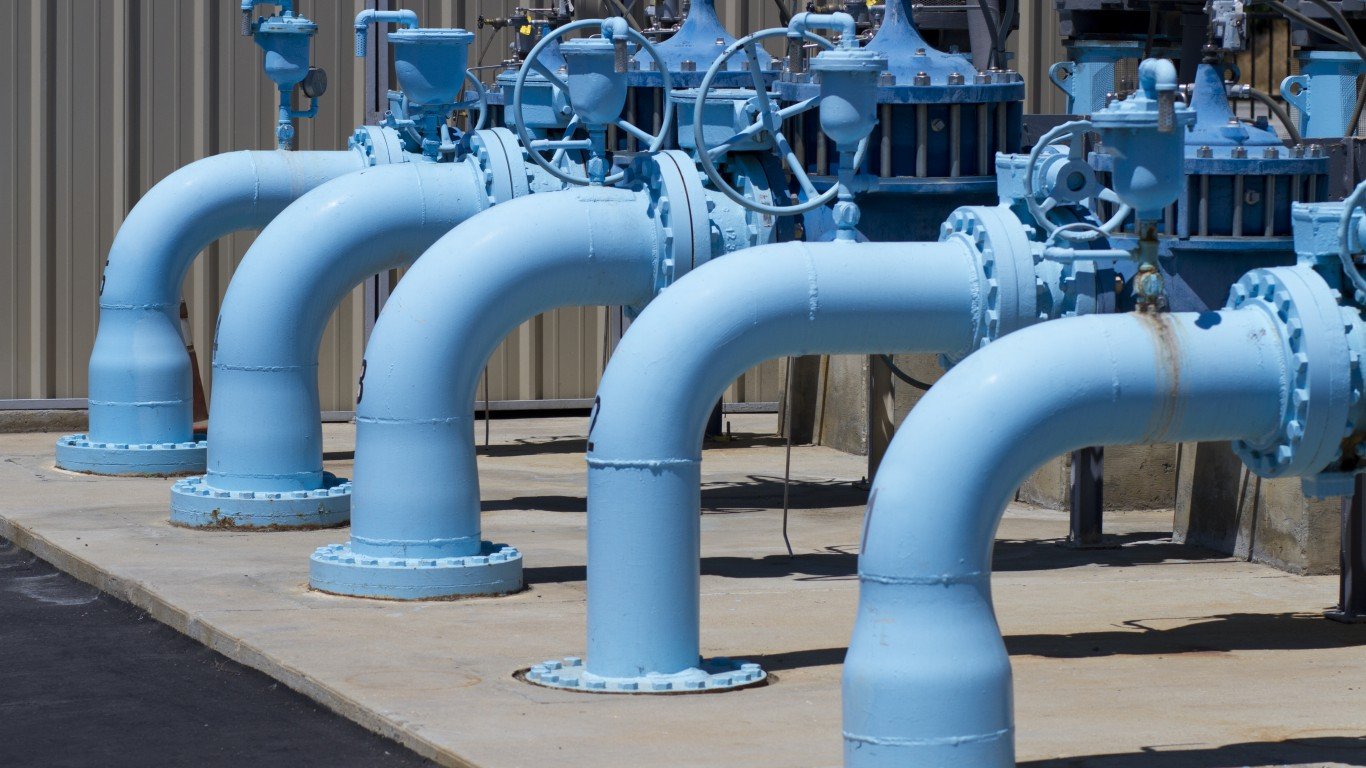
21. Pumping station operators
> Average decibel level: 88.4 dBA (1.7% lower than the OSHA limit)
> Total employment, 2019: 26,420
> Annual median wage: $52,240
Pumping station operators can work a variety of jobs around wells that pump resources like butane, nitrogen, hydrogen, and natural gas. The machinery needed to extract these resources tend to be loud, and even though the average decibel level comes in just under the maximum permissible level of 90 dBA, most OSHA measurements of these work environments exceeded that level.
Pumping station operator jobs come with many hazards, and workers must wear protective gear each day, including hearing protection.
[in-text-ad-2]

20. Conveyor operators and tenders
> Average decibel level: 88.6 dBA (1.6% lower than the OSHA limit)
> Total employment, 2019: 24,050
> Annual median wage: $34,660
Workers in this occupation operate and tend to conveyor belts that move materials and products. These workers are most commonly employed in warehouses, mines, mills, and other manufacturing plants — all of which utilize noisy machinery throughout the day.
With an average decibel level of 88.6 dBA, these workers operate just below the maximum threshold of an average noise level of 90 dBA. Though most workplaces in this occupation operate under this threshold, more than 80% operate above 85 dBA, the level at which workplaces are encouraged to provide hearing protection.

19. Physicians and surgeons
> Average decibel level: 88.7 dBA (1.4% lower than the OSHA limit)
> Total employment, 2019: 580,930
> Annual median wage: $205,915
Physicians and surgeons often contend with a significant amount of noise pollution on the job. Most commonly, it comes from equipment used in surgery or medical procedures, trolley movement, and personnel conversation. Sometimes, studies have shown the noise level in operating rooms can exceed 100 dBA. Orthopedic operating rooms tend to be the loudest.
Physicians and surgeons are not just the highest paid workers on this list, but the highest paid workers in the U.S. overall, with an annual median wage of nearly $206,000.
[in-text-ad]

18. Construction laborers
> Average decibel level: 89.0 dBA (1.1% lower than the OSHA limit)
> Total employment, 2019: 1,020,350
> Annual median wage: $36,860
Construction laborers are in one of just 19 jobs in which the average decibel level throughout the workday is 89 dBA. These workers are regularly exposed to the sounds of jackhammers, generators, traffic, and other loud machines. According to the CDC, the majority of construction workers have been exposed to hazardous noise, yet more than 30% reported that they do not use any kind of hearing protection.
Roughly a quarter of tested construction laborers were found to have a material hearing impairment, or a hearing loss that impacts day-to-day activities. Construction laborers have by far the largest labor force of any of the 25 noisiest jobs in America, with over 1 million people.

17. Shoe and leather workers
> Average decibel level: 89.1 dBA (1.0% lower than the OSHA limit)
> Total employment, 2019: 13,780
> Annual median wage: $29,830
Shoe and leather workers build or repair leather products or shoes, often with noisy machinery. These workers are exposed to an average decibel level of over 89 dBA throughout their day. More than half of all shoe and leather work sites average more than 90 dBA throughout a typical workday, and more than 88% exceed 85 dBA, a level at which employers should provide workers with hearing protection.
Studies have shown that some workers in the shoe and leather working industry have suffered moderate to severe hearing loss after being exposed to chronic noise on the job.
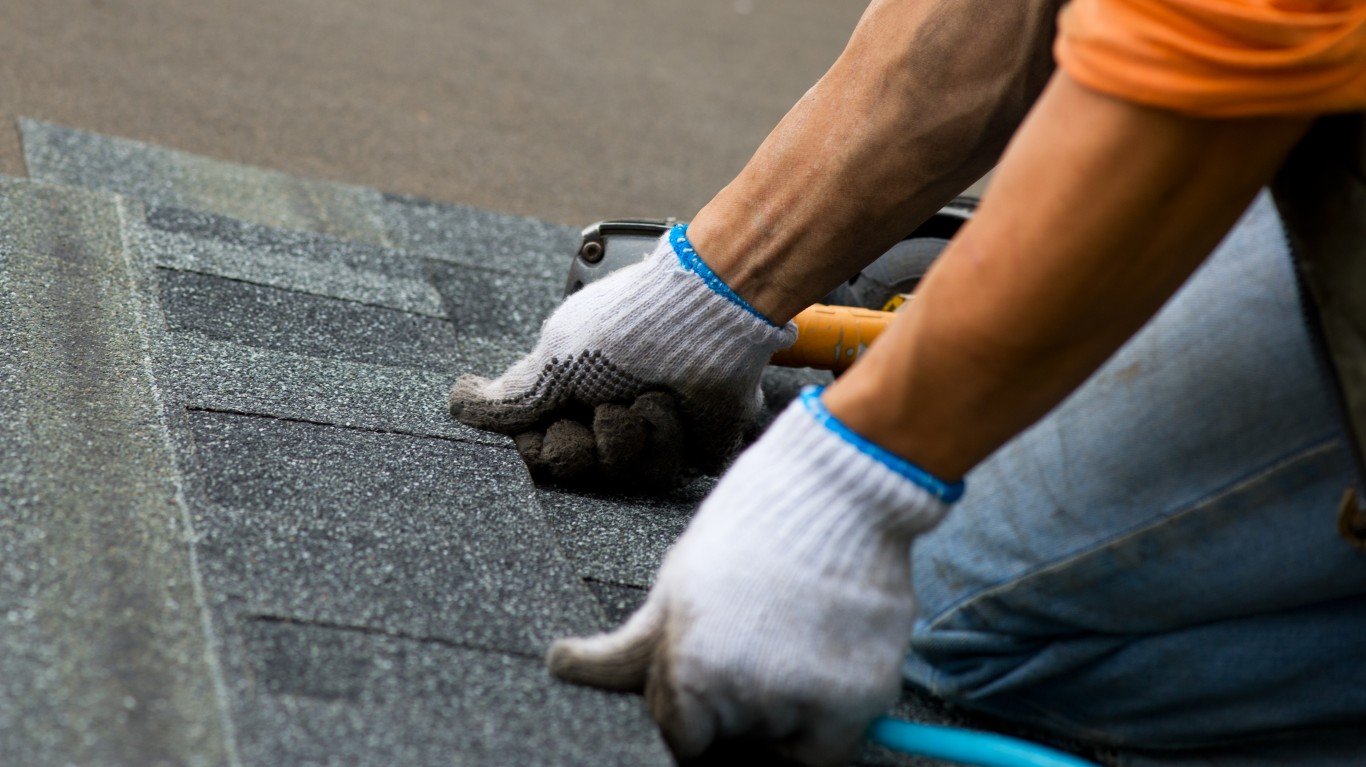
16. Roofers
> Average decibel level: 89.2 dBA (0.9% lower than the OSHA limit)
> Total employment, 2019: 129,690
> Annual median wage: $42,100
People who work to install, repair, and replace roofing are exposed to a number of potentially damaging noises throughout their workday. These include nail guns, roof cutters, power generators, motorized pumps, and propane burners, as well as construction equipment that is frequently nearby at other job sites.
Though the average decibel level is nearly at OSHA’s permissible exposure limit of 90 dBA, most measurements of roofers’ work environments found noise levels were lower than 90 dBA, though nearly all measurements exceeded the 85 dBA level at which employers are encouraged to give hearing protection to their workers.
[in-text-ad-2]

15. Cabinetmakers and bench carpenters
> Average decibel level: 89.4 dBA (0.6% lower than the OSHA limit)
> Total employment, 2019: 99,400
> Annual median wage: $35,790
Cabinetmakers and bench carpenters cut and shape wood as they construct cabinets and other wooden items. These workers use a litany of noisy machines and tools in their job, including many kinds of drills and saws, wrenches, sanders, planers, routers, and more.
A National Institute for Occupational Safety and Health study found that 25-year-old carpenters have hearing levels that would tend to be more comparable to a non-noise exposed 50-year-old.
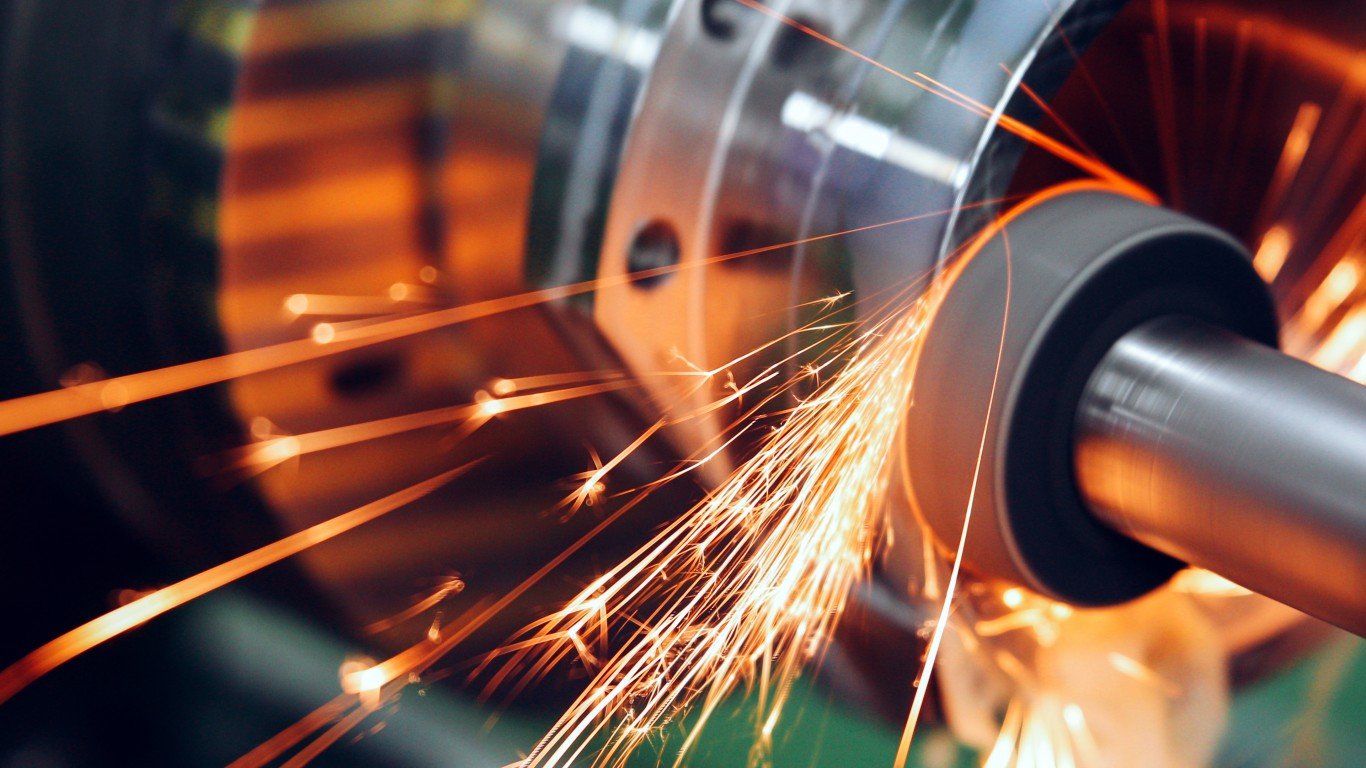
14. Miscellaneous metal workers and plastic workers
> Average decibel level: 89.5 dBA (0.5% lower than the OSHA limit)
> Total employment, 2019: 100,300
> Annual median wage: $36,050
Miscellaneous metal and plastic workers include heat treating equipment setters, layout workers, tool grinders, and more. These workers use large, noisy machines to create items made of metal or plastic.
Among thousands of OSHA measurements, the agency found that over 88% of workers in these occupations were in an environment in which the average decibel level exceeded 85 dBA, and 54% were in an environment in which the decibel level exceeded 90 dBA.
[in-text-ad]

13. Logging workers
> Average decibel level: 89.6 dBA (0.4% lower than the OSHA limit)
> Total employment, 2019: 37,960
> Annual median wage: $41,230
Logging workers are in one of the noisiest jobs in America for one main reason — chainsaws. These workers use chainsaws and other similar implements to fell trees. Chainsaws are among the noisiest tools a worker in any job would regularly use, producing decibel levels of around 115 dBA — well beyond the threshold of noises considered safe, which is generally thought to be around 80-85 dBA.
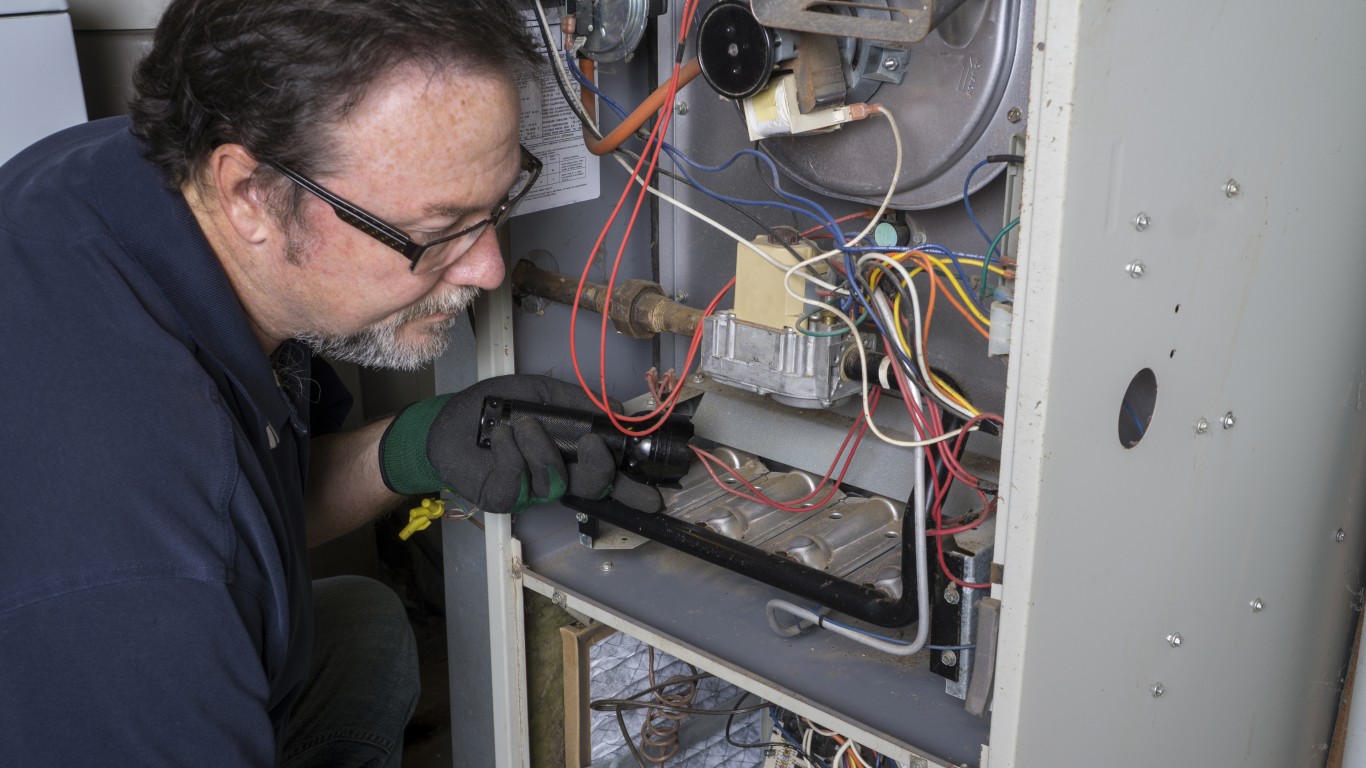
12. Furnace, kiln, oven, drier, and kettle operators and tenders
> Average decibel level: 89.7 dBA (0.4% lower than the OSHA limit)
> Total employment, 2019: 18,970
> Annual median wage: $40,090
Those who work with furnaces, kilns, ovens, and other similar heating equipment perform a variety of tasks at work. These can include drying lumber, curing rubber, boiling soap, removing moisture from materials, and more.
More than half of all OSHA measurements taken at these kinds of work environments found an average decibel level of over 90 dBA and nearly 83% had an average level of over 85 dBA. Heating equipment is known to produce low-frequency sound, and it can be more difficult to reduce the effects of these sounds with common solutions like simply blocking them with a barrier.

11. Gaming services workers
> Average decibel level: 89.8 dBA (0.3% lower than the OSHA limit)
> Total employment, 2019: 119,330
> Annual median wage: $21,730
Gaming services workers serve customers in racetracks, casinos, and other places where they can gamble. Casino floors are relatively noisy places, with ambient noise levels around 85 dBA due to loud electronic slot machines, buzzers and bells sounding when someone wins, and conversations at gaming tables.
Gaming services workers have by far the lowest income of any job on this list. Their annual median wage of $21,730 is well below the annual median wage of $39,810.
[in-text-ad-2]

10. Textile machine setters, operators, and tenders
> Average decibel level: 89.9 dBA (0.1% lower than the OSHA limit)
> Total employment, 2019: 74,220
> Annual median wage: $29,640
Textile machine setters, operators, and tenders work in an environment in which the average decibel level is 89.9 dBA throughout the workday, just slightly below the permissible exposure limit of 90 dBA set by OSHA. More than 90% of workers in this occupation should be provided with hearing protection, as the average decibel level they are exposed to exceeds 85 dBA.
These workers, who bleach, dye, cut, knit, or wind textiles, are at a high risk of developing hearing loss as a result of the loud equipment used to do their jobs.

9. Ushers, lobby attendants, and ticket takers
> Average decibel level: 90.0 dBA (right at the OSHA limit)
> Total employment, 2019: 138,160
> Annual median wage: $23,500
Ushers, lobby attendants, and ticket takers work in one of 10 jobs in which the average decibel level they are exposed to throughout their workday is at or above OSHA’s permissible limit of 90 decibels.
These workers are most commonly employed by movie theaters, concert and performing art venues, and spectator sporting events, all of which can be very loud. For instance, the average NFL game maintains a noise level of about 90 dBA throughout, though several games have hit levels exceeding 130 or even 140 dBA.
[in-text-ad]
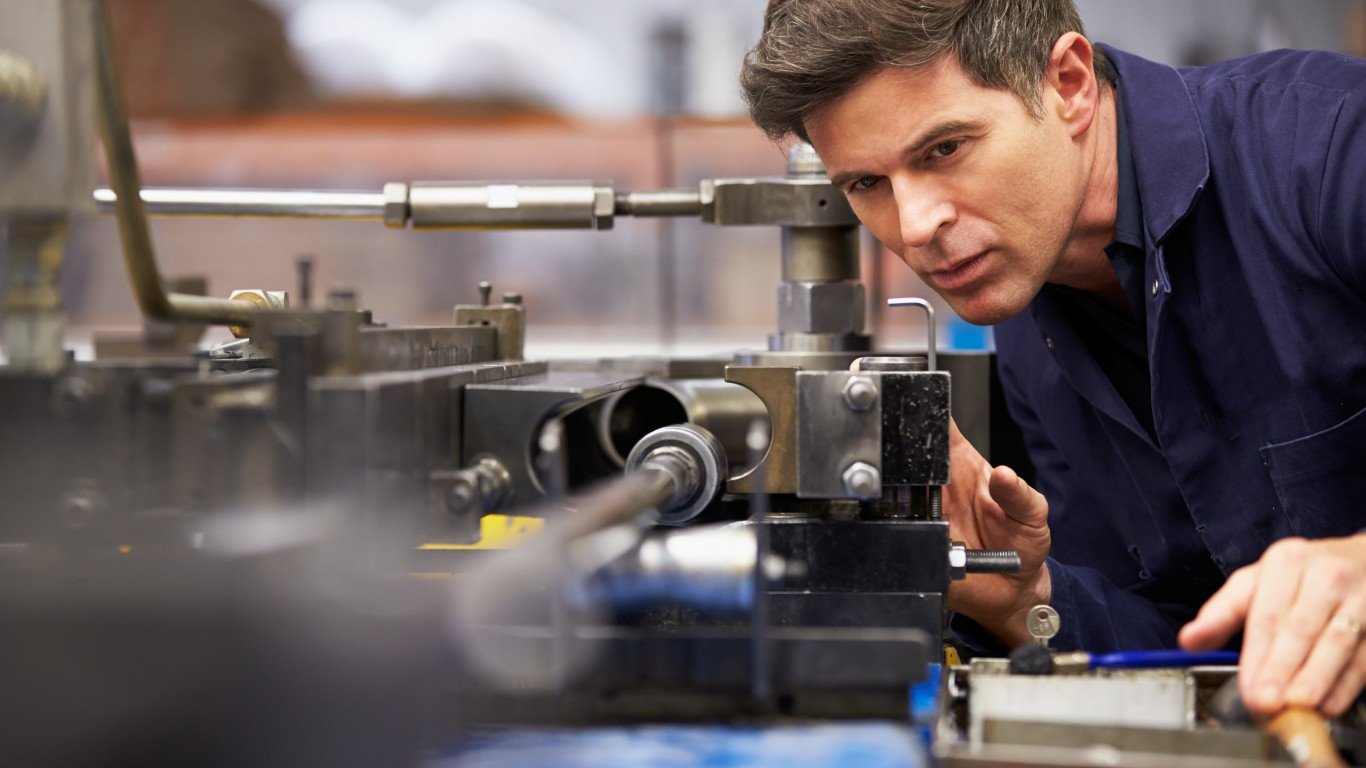
8. Control and valve installers and repairers
> Average decibel level: 90.3 dBA (0.3% higher than the OSHA limit)
> Total employment, 2019: 75,320
> Annual median wage: $50,640
Control and valve installers and repairers work with mechanical regulating and controlling devices, such as hydraulic doors, electric meters, gas regulators, thermostats, safety and flow valves, and other mechanical governors. Hydraulic systems can often produce loud noises, from the mechanisms themselves and from doors loudly slamming shut.
Though the job ranks among the noisiest, control and valve workers have experienced reduced hearing hazards in recent years. OSHA measurements have found the average decibel level has declined from the 1980s and 1990s.

7. Miscellaneous agricultural workers
> Average decibel level: 90.9 dBA (1.0% higher than the OSHA limit)
> Total employment, 2019: 365,680
> Annual median wage: $25,820
Miscellaneous agricultural workers include equipment operators, crop, nursery and greenhouse laborers, animal workers, and more. These workers are exposed to an average noise level of nearly 91 dBA throughout their day, higher than the permissible exposure limit set by OSHA.
Equipment operators must use noisy equipment like tractors, combines, chainsaws, grain dryers, and more. These can all exceed 90 dBA. Animal workers can experience hearing loss as a result of firearms as well as pig squeals, which can hit 100 dBA.

6. Forming machine setters, operators, and tenders, metal and plastic
> Average decibel level: 91.0 dBA (1.1% higher than the OSHA limit)
> Total employment, 2019: 125,730
> Annual median wage: $37,690
Metal and plastic forming machine setters, operators and tenders work in one of 11 production occupations that rank among the 24 noisiest jobs in America. People in this occupation work with machines that extrude, draw, forge, and roll metals and plastics.
These workers are often employed in large industrial settings, like iron and steel mills, machine shops, and motor vehicle part manufacturing plants. These places often have loud machinery running throughout the day, producing an average decibel level of 91 dBA — higher than the level at which hearing loss occurs, and louder than the permissible limit set by OSHA.
[in-text-ad-2]

5. Tailors, dressmakers, and sewers
> Average decibel level: 91.1 dBA (1.2% higher than the OSHA limit)
> Total employment, 2019: 28,880
> Annual median wage: $31,230
Tailors, dressmakers, and sewers make, alter, and repair garments. Large industrial sewing machines have been found to produce noise around 90 dBA, the maximum permissible level a work environment can average throughout a full eight-hour day.
OSHA found that more than 72% of tailors, dressmakers, and sewers work in a place where the average noise level throughout the workday exceeded 85 dBA, and nearly 65% work in an environment where the noise level averages more than 90 dBA.

4. Butchers and other meat, poultry, and fish processing workers
> Average decibel level: 91.1 dBA (1.2% higher than the OSHA limit)
> Total employment, 2019: 364,150
> Annual median wage: $29,520
Meat, poultry, and fish processors work with noisy machinery and equipment throughout their entire day. Nearly 95% of OSHA measurements in meat processing work environments found the average noise level exceeded 85 dBA — the level at which workplaces are encouraged by OSHA to provide workers with hearing protection.
The relatively high decibel level at this job has led to a high incidence of hearing loss among workers. The rate of hearing loss in animal slaughtering and processing workers is 43.0 per 10,000 workers, compared with a rate of 1.8 for all private industry jobs.
[in-text-ad]
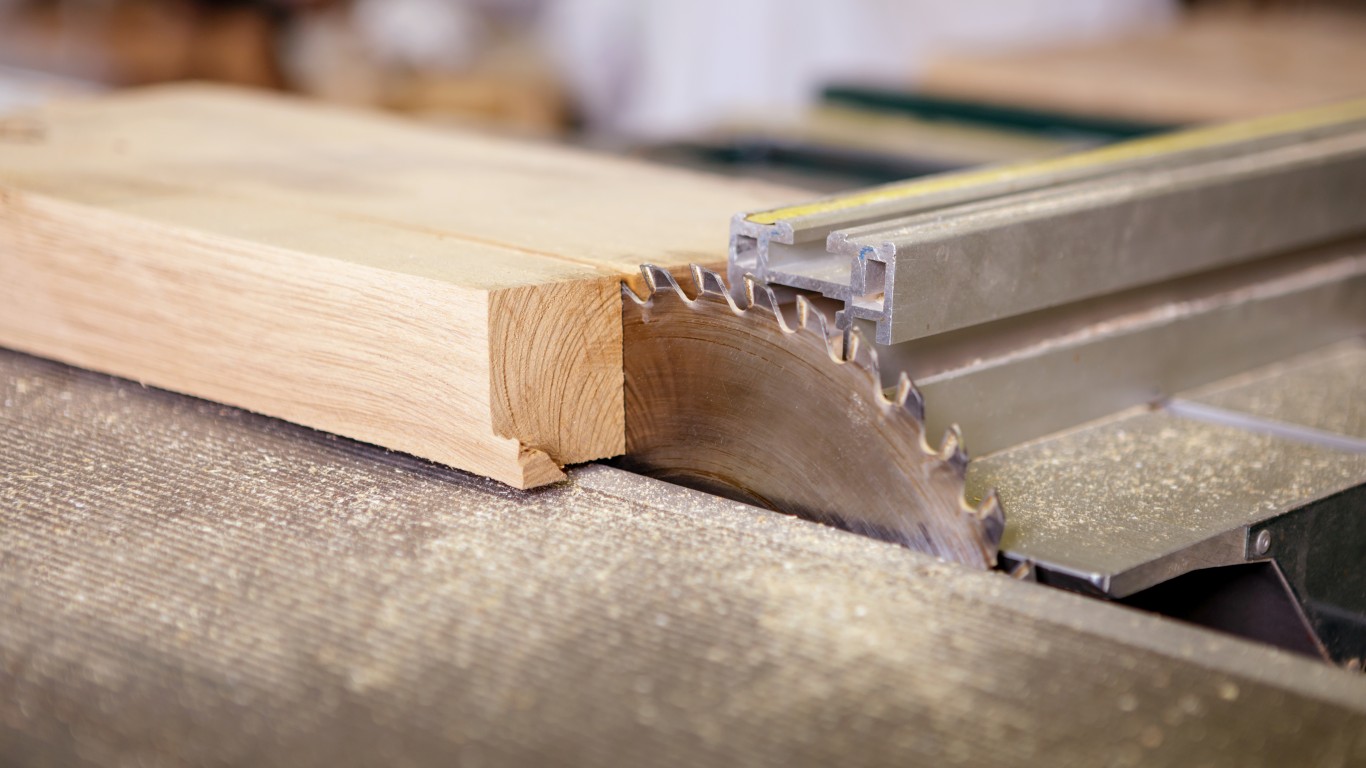
3. Woodworking machine setters, operators, and tenders
> Average decibel level: 92.5 dBA (2.8% higher than the OSHA limit)
> Total employment, 2019: 129,580
> Annual median wage: $30,760
Woodworking machine setters, operators, and tenders use a variety of machines to cut, shape, and craft wood. These include saws, drill presses, lathes, shapers, routers, sanders, planers, and wood nailing machines.
Such machines produce noise that regularly exceeds 100 dBA, and throughout a workday in this occupation, the average noise level is 92.5 dBA — the third highest among all occupations and beyond the permissible level set by OSHA.

2. Farmers, ranchers, and other agricultural managers
> Average decibel level: 92.5 dBA (2.8% higher than the OSHA limit)
> Total employment, 2019: 5,060
> Annual median wage: $71,160
Farmers, ranchers, and other agricultural managers are often jacks of all trades, working with a variety of equipment to produce crops, livestock, and dairy. They often use equipment that is very loud such as lawnmowers, tractors, and chainsaws, which typically produce over 100 decibels.
Throughout the workday of a farmer, rancher, or agricultural managers, the average noise level exceeds the maximum safe level by 2.5 decibels.

1. Emergency medical technicians and paramedics
> Average decibel level: 98.4 dBA (9.3% higher than the OSHA limit)
> Total employment, 2019: 260,600
> Annual median wage: $35,400
No job faces more consistently noisy working conditions than emergency medical technicians and paramedics. These workers are first responders to medical emergencies, and they perform medical care and transport patients to medical facilities.
Throughout the workday, EMTs and paramedics are within earshot of sirens, horns, diesel motors, radios, shouting, power tools, and alarms on a regular basis. This all adds up to an average decibel level of 98.4 dBA during a workday — by far the highest of any job, and nearly 10% higher than the OSHA permissible limit.
Ambulance sirens generally exceed 120 dBA, yet over a third of EMTs and paramedics do not use ear-protective gear. Nearly half of all emergency medical service providers reported having mild to moderate hearing loss.
Methodology
To determine the noisiest jobs, 24/7 Wall St. reviewed data on noise exposure by occupation from the University of Michigan’s Job Exposure Matrix. Occupations were ranked based on the average level of exposure to noise for all workers, measured in A-weighted decibels (dBA). Data on dBA was averaged across all years for which data was available.
Imputed data with a high level of confidence was included, while imputed data with a low to moderate level of confidence was excluded. Noise exposure was compared against the Occupational Safety and Health Administration’s permissible exposure limit of 90 dBA during an eight-hour workday. Data on total employment and median annual wage came from the Bureau of Labor Statistics’ May 2019 Occupational Employment Statistics program. Data on projected employment growth from 2019 to 2029 came from the BLS Employment Projections program.
Sponsored: Attention Savvy Investors: Speak to 3 Financial Experts – FREE
Ever wanted an extra set of eyes on an investment you’re considering? Now you can speak with up to 3 financial experts in your area for FREE. By simply
clicking here you can begin to match with financial professionals who can help guide you through the financial decisions you’re making. And the best part? The first conversation with them is free.
Click here to match with up to 3 financial pros who would be excited to help you make financial decisions.
Thank you for reading! Have some feedback for us?
Contact the 24/7 Wall St. editorial team.
 24/7 Wall St.
24/7 Wall St.


